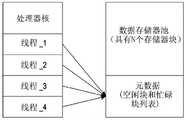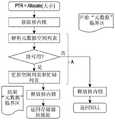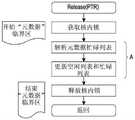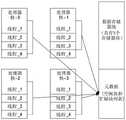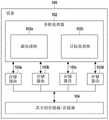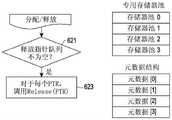CN115605846A - Apparatus and method for managing shareable resources in a multi-core processor - Google Patents
Apparatus and method for managing shareable resources in a multi-core processorDownload PDFInfo
- Publication number
- CN115605846A CN115605846ACN201980029692.3ACN201980029692ACN115605846ACN 115605846 ACN115605846 ACN 115605846ACN 201980029692 ACN201980029692 ACN 201980029692ACN 115605846 ACN115605846 ACN 115605846A
- Authority
- CN
- China
- Prior art keywords
- core
- processing core
- release
- resources
- shareable
- Prior art date
- Legal status (The legal status is an assumption and is not a legal conclusion. Google has not performed a legal analysis and makes no representation as to the accuracy of the status listed.)
- Pending
Links
Images
Classifications
- G—PHYSICS
- G06—COMPUTING OR CALCULATING; COUNTING
- G06F—ELECTRIC DIGITAL DATA PROCESSING
- G06F9/00—Arrangements for program control, e.g. control units
- G06F9/06—Arrangements for program control, e.g. control units using stored programs, i.e. using an internal store of processing equipment to receive or retain programs
- G06F9/46—Multiprogramming arrangements
- G06F9/50—Allocation of resources, e.g. of the central processing unit [CPU]
- G06F9/5005—Allocation of resources, e.g. of the central processing unit [CPU] to service a request
- G06F9/5011—Allocation of resources, e.g. of the central processing unit [CPU] to service a request the resources being hardware resources other than CPUs, Servers and Terminals
- G06F9/5016—Allocation of resources, e.g. of the central processing unit [CPU] to service a request the resources being hardware resources other than CPUs, Servers and Terminals the resource being the memory
- G—PHYSICS
- G06—COMPUTING OR CALCULATING; COUNTING
- G06F—ELECTRIC DIGITAL DATA PROCESSING
- G06F9/00—Arrangements for program control, e.g. control units
- G06F9/06—Arrangements for program control, e.g. control units using stored programs, i.e. using an internal store of processing equipment to receive or retain programs
- G06F9/46—Multiprogramming arrangements
- G06F9/50—Allocation of resources, e.g. of the central processing unit [CPU]
- G06F9/5005—Allocation of resources, e.g. of the central processing unit [CPU] to service a request
- G06F9/5011—Allocation of resources, e.g. of the central processing unit [CPU] to service a request the resources being hardware resources other than CPUs, Servers and Terminals
- G06F9/5022—Mechanisms to release resources
- G—PHYSICS
- G06—COMPUTING OR CALCULATING; COUNTING
- G06F—ELECTRIC DIGITAL DATA PROCESSING
- G06F9/00—Arrangements for program control, e.g. control units
- G06F9/06—Arrangements for program control, e.g. control units using stored programs, i.e. using an internal store of processing equipment to receive or retain programs
- G06F9/46—Multiprogramming arrangements
- G06F9/52—Program synchronisation; Mutual exclusion, e.g. by means of semaphores
- G06F9/526—Mutual exclusion algorithms
- G—PHYSICS
- G06—COMPUTING OR CALCULATING; COUNTING
- G06F—ELECTRIC DIGITAL DATA PROCESSING
- G06F9/00—Arrangements for program control, e.g. control units
- G06F9/06—Arrangements for program control, e.g. control units using stored programs, i.e. using an internal store of processing equipment to receive or retain programs
- G06F9/46—Multiprogramming arrangements
- G06F9/54—Interprogram communication
- G06F9/544—Buffers; Shared memory; Pipes
Landscapes
- Engineering & Computer Science (AREA)
- Software Systems (AREA)
- Theoretical Computer Science (AREA)
- Physics & Mathematics (AREA)
- General Engineering & Computer Science (AREA)
- General Physics & Mathematics (AREA)
- Storage Device Security (AREA)
- Information Retrieval, Db Structures And Fs Structures Therefor (AREA)
Abstract
Description
Translated fromChinese技术领域technical field
本公开涉及计算机系统。并且更具体地,本公开涉及使数据流并行化以用于计算机系统内的分布式处理。This disclosure relates to computer systems. And more particularly, the present disclosure relates to parallelizing data streams for distributed processing within computer systems.
背景技术Background technique
当前,包括多核处理器平台(诸如非对称多处理模式(AMP)、对称多处理(SMP)模式和绑定多处理(BMP)模式)的可编程计算机系统可能需要对可共享资源的并发访问的有效管理。通常,操作系统(OS)或实时操作系统(RTOS)可提供处理器间通信(IPC)方法。此外,OS/RTOS可提供跨核的资源锁定方法(诸如自旋锁),并且OS/RTOS可提供跨核内的线程的资源锁定方法(诸如信号标、核内锁(int-lock)),以避免对共享资源(诸如外围端口、存储器等)的并发访问。此外,对于多核处理器的动态资源管理可能需要处理元数据(诸如资源可用性信息),其中,元数据可以是共享资源。常规方法可通过锁定(诸如核内锁、信号标和自旋锁)来处理可共享资源。然而,常规锁定方法可能影响性能。频繁的资源锁定和等待解锁会影响多核系统/处理器中的并行性。此外,核/线程可能不完全利用专用存储器,从而浪费可用存储器。Currently, programmable computer systems including multi-core processor platforms such as Asymmetric Multiprocessing Mode (AMP), Symmetric Multiprocessing (SMP) Mode, and Bound Multiprocessing (BMP) Mode may require the ability to concurrently access sharable resources effective management. Typically, an operating system (OS) or real-time operating system (RTOS) may provide an interprocessor communication (IPC) method. Furthermore, an OS/RTOS may provide resource locking methods across cores (such as spin locks), and an OS/RTOS may provide resource locking methods (such as semaphores, int-locks) across threads within a core, To avoid concurrent access to shared resources (such as peripheral ports, memory, etc.). In addition, dynamic resource management for multi-core processors may require processing metadata (such as resource availability information), where the metadata may be shared resources. Conventional approaches may handle shareable resources through locks such as in-kernel locks, semaphores, and spinlocks. However, conventional locking methods can affect performance. Frequent resource locking and waiting to unlock can affect parallelism in multi-core systems/processors. Also, cores/threads may not fully utilize private memory, wasting available memory.
因此,将参照如下的图1a至图3b描述根据现有技术的用于在单核处理器和多核处理器中访问可共享资源的常规方法。Therefore, conventional methods for accessing shareable resources in single-core processors and multi-core processors according to the prior art will be described with reference to FIGS. 1a to 3b as follows.
图1a示出常规单核处理器访问可共享资源的框图。单个处理器核可具有将被运行的多个线程。此外,单个数据存储器池和单个元数据文件被分配以用于单核处理器运行线程。此外,由处理器进行的存储器分配和解除分配可能需要具有核内锁(即,中断锁)以用于保护临界区(critical section)(诸如元数据文件)。可跨越多个线程保护元数据文件。Figure 1a shows a block diagram of a conventional single-core processor accessing a sharable resource. A single processor core can have multiple threads to be run. Additionally, a single data memory pool and a single metadata file are allocated for a single-core processor to run threads. Furthermore, memory allocation and deallocation by the processor may require having in-kernel locks (ie, interrupt locks) for protecting critical sections (such as metadata files). Metadata files can be protected across multiple threads.
图1b和图1c是描绘由单核处理器访问可共享资源的常规方法的流程图。1b and 1c are flowcharts depicting conventional methods of accessing sharable resources by a single-core processor.
存储器分配/解除分配可能需要具有核内锁(即,中断锁)和核间锁(即,自旋锁)两者以用于保护临界区(诸如元数据)。在获取核内锁步骤,处理器可禁用中断并且可不允许另一线程运行。在释放核内锁步骤(图1c中所示),处理器可允许等待线程恢复并再次从获取核内锁开始。标记为“A”的步骤可以是临界区。在临界区中,处理器可一次允许一个线程,并且其它线程可能需要在获取核内锁步骤等待。Memory allocation/deallocation may require having both intra-core locks (ie interrupt locks) and inter-core locks (ie spin locks) for protecting critical sections such as metadata. At the step of acquiring the in-kernel lock, the processor may disable interrupts and may not allow another thread to run. In the release kernel lock step (shown in FIG. 1 c ), the processor may allow the waiting thread to resume and start again from acquiring the kernel lock. A step labeled "A" may be a critical section. In a critical section, the processor may allow one thread at a time, and other threads may need to wait while acquiring an in-kernel lock.
图2a示出常规多核处理器访问可共享资源的框图。Figure 2a shows a block diagram of a conventional multi-core processor accessing sharable resources.
具有每个核的多核处理器可具有将被运行的多个线程。多核处理器可被分配有单个数据存储器池和单个元数据文件以运行多个线程。此外,存储器分配和解除分配可能需要具有核间锁(即,自旋锁)和核内锁(即,中断锁)以用于保护临界区(诸如元数据文件)。锁可影响多核处理器中的并行性。A multi-core processor with each core can have multiple threads to be run. A multi-core processor can be assigned a single data memory pool and a single metadata file to run multiple threads. Furthermore, memory allocation and deallocation may require having inter-core locks (ie, spin locks) and intra-core locks (ie, interrupt locks) for protecting critical sections (such as metadata files). Locks can affect parallelism in multicore processors.
图2b示出常规多核处理器访问针对处理器的每个核的专用元数据文件中的可共享资源的框图。Figure 2b shows a block diagram of a conventional multi-core processor accessing sharable resources in dedicated metadata files for each core of the processor.
元数据文件可针对处理器的每个核被分配。此外,每个线程可在访问专用元数据文件时应用核内锁。然而,在临界区(诸如元数据文件)的解除分配或释放期间,可能需要核间锁来保护元数据。A metadata file may be allocated for each core of the processor. Additionally, each thread can apply an in-kernel lock when accessing a private metadata file. However, inter-core locks may be required to protect metadata during deallocation or deallocation of critical sections such as metadata files.
图2c示出常规多核处理器基于跨核释放访问可共享资源的框图。Fig. 2c shows a block diagram of a conventional multi-core processor accessing sharable resources based on cross-core release.
在跨核释放场景中,核-0可从与核-0相关联的存储器池-0分配1个存储器块。关于分配的存储器块的信息可由核-0更新到与核-0相关联的元数据-0文件。此外,核-0可将存储器块数据共享给核-1。然而,在临界区(诸如元数据文件)的解除分配或释放期间,可能需要核间锁来保护元数据。In a cross-core deallocation scenario, core-0 may allocate 1 memory block from memory pool-0 associated with core-0. Information about allocated memory blocks may be updated by Core-0 to the Metadata-0 file associated with Core-0. Additionally, Core-0 may share memory block data to Core-1. However, inter-core locks may be required to protect metadata during deallocation or deallocation of critical sections such as metadata files.
图2d示出常规多核处理器访问同一元数据块以分配存储器块的框图。Figure 2d shows a block diagram of a conventional multi-core processor accessing the same metadata block to allocate memory blocks.
在跨核释放场景中,核-1可将与核-0共享的块-0释放到元数据-0块。同时,核-0可尝试通过访问元数据-0文件/块来将另一块分配给另一核。然而,元数据-0仍然可以是公共/可共享资源和临界区。因此,可能无法避免核间锁(即,自旋锁)。In a cross-core release scenario, core-1 may release block-0 shared with core-0 to metadata-0 block. Meanwhile, Core-0 may try to allocate another block to another core by accessing the Metadata-0 file/block. However, metadata-0 can still be public/shareable resources and critical sections. Therefore, inter-core locks (ie, spin locks) may not be avoided.
图3a和图3b是描绘用于由多核处理器进行分配和释放的常规方法的流程图。为了在解除属于不同核的指针的情况下访问忙碌列表和空闲列表,常规方法可能需要保护临界区元数据,从而专用资源可能不利于多核实现并行。在标记为“B”的临界区(图3a和图3b中所示)中,核-0中的线程_1可获取核内锁并且可获取自旋锁。因此,核0中的其它线程可能需要等待释放核内锁。此外,核-1、核-2和核-3可能需要等待释放自旋锁。3a and 3b are flowcharts depicting conventional methods for allocation and deallocation by a multi-core processor. In order to access the busy list and free list in the case of freeing pointers belonging to different cores, conventional methods may need to protect critical section metadata, so that dedicated resources may not be conducive to multi-core parallelism. In the critical section labeled "B" (shown in Figures 3a and 3b), Thread_1 in Core-0 can acquire an in-core lock and can acquire a spinlock. Therefore, other threads in core 0 may need to wait for the in-core lock to be released. Also, core-1, core-2, and core-3 may need to wait for the spinlock to be released.
在常规方法中,动态存储器管理解决方案可使用每核/每线程静态资源(存储器)分配来处理传入数据流块并释放数据流块。因此,由处理器进行的分配可使用静态分配并且由相同的核/线程释放资源(存储器)。然而,如果由特定核分配的资源被其它核解除分配/释放,则对公共/可共享资源的访问可能具有访问冲突。In a conventional approach, a dynamic memory management solution may use per-core/per-thread static resource (memory) allocations to process incoming dataflow blocks and free dataflow blocks. Therefore, allocations by the processor may use static allocations and release resources (memory) by the same core/thread. However, accesses to common/shareable resources may have access violations if resources allocated by a particular core are deallocated/released by other cores.
然而,常规方法不可以从一个核/线程进行分配并且由另一核/线程释放存储器/缓冲器。在多线程/多核系统的情况下,常规方法不可以具有动态缓冲器访问和释放。However, conventional methods cannot allocate from one core/thread and free memory/buffers by another core/thread. In the case of multi-threaded/multi-core systems, conventional methods cannot have dynamic buffer access and release.
发明内容Contents of the invention
技术问题technical problem
已经做出本公开以至少解决上述问题和/或缺点并且至少提供下面描述的优点。因此,本公开的一方面在于提供一种用于在计算环境中管理与多核处理器相关联的可共享资源的设备和方法。The present disclosure has been made to address at least the above-mentioned problems and/or disadvantages and to provide at least the advantages described below. Accordingly, an aspect of the present disclosure is to provide an apparatus and method for managing sharable resources associated with a multi-core processor in a computing environment.
本公开的另一方面在于提供用于通过具有每核/每线程专用资源池和元数据来在多核处理器中进行资源管理的设备和方法。Another aspect of the present disclosure is to provide an apparatus and method for resource management in a multi-core processor by having per-core/per-thread dedicated resource pools and metadata.
本公开的另一方面在于提供用于使用具有排他子队列集合的专用释放队列管理来对资源进行跨核解除分配的设备和方法。Another aspect of the present disclosure is to provide apparatus and methods for cross-core deallocation of resources using dedicated release queue management with an exclusive set of subqueues.
本公开的另一方面在于提供用于监视每个存储器池的占用水平并且以无锁方式动态地调整每个池的分配的设备和方法。Another aspect of the present disclosure is to provide apparatus and methods for monitoring the occupancy level of each memory pool and dynamically adjusting the allocation of each pool in a lock-free manner.
技术方案Technical solutions
因此,本文的实施例提供一种用于在多核处理器中管理可共享资源的方法。所述方法包括:由目标处理核访问与源处理核相关联的可共享资源。源处理核和目标处理核驻留在多核处理器中。所述方法包括:由源处理核基于访问的可共享资源在与源处理核的释放队列中生成与至少一个目标处理核中的每个目标处理核相应的多个释放子队列,以释放由源处理核指派给所述目标处理核的可共享资源。所述方法包括:基于分析与可共享资源相关的第一信息,由所述目标处理核将至少一个访问的可共享资源释放到在源处理核的释放队列中的生成的各自的多个释放子队列。与可共享资源相关的第一信息被存储在元数据文件中。所述方法包括:由源处理核基于识别出释放队列中的可共享资源的释放,更新存储的与源处理核相应的元数据文件中的第二信息。Accordingly, embodiments herein provide a method for managing sharable resources in a multi-core processor. The method includes accessing, by a target processing core, a shareable resource associated with a source processing core. The source processing core and target processing core reside in the multi-core processor. The method includes: the source processing core generates a plurality of release sub-queues corresponding to each target processing core in at least one target processing core in the release queue of the source processing core based on the accessed shareable resources, so as to release the A shareable resource assigned by a processing core to the target processing core. The method includes releasing, by the target processing core, at least one accessed sharable resource to a respective plurality of release objects generated in a release queue of the source processing core based on analyzing first information related to the sharable resource. queue. First information related to the shareable resource is stored in a metadata file. The method includes: updating, by the source processing core, second information stored in a metadata file corresponding to the source processing core based on identifying the release of the shareable resource in the release queue.
因此,本文的实施例提供一种用于在多核处理器中管理可共享资源的设备。所述设备被配置为由目标处理核访问与源处理核相关联的可共享资源。所述设备被配置为:由源处理核基于访问的可共享资源,在与源处理核的释放队列中生成与至少一个目标处理核中的每个目标处理核相应的多个释放子队列,以释放由源处理核指派给目标处理核的可共享资源。所述设备被配置为:由目标处理核基于分析与可共享资源相关的第一信息,将至少一个访问的可共享资源释放到源处理核的释放队列中的生成的各自的多个释放子队列,其中,与可共享资源相关的第一信息被存储在元数据文件中。所述设备被配置为:由源处理核基于识别出释放队列中的可共享资源的释放,更新存储的与源处理核相应的元数据文件中的第二信息。Accordingly, embodiments herein provide an apparatus for managing sharable resources in a multi-core processor. The device is configured for a target processing core to access a sharable resource associated with a source processing core. The device is configured to: the source processing core generates a plurality of release subqueues corresponding to each target processing core in the at least one target processing core in the release queue of the source processing core based on the accessed shareable resources, so as to Releases the shareable resources assigned by the source processing core to the target processing core. The device is configured to release, by the target processing core, at least one accessed shareable resource to the respective plurality of release subqueues generated in the release queue of the source processing core based on analyzing the first information related to the shareable resource , wherein the first information related to the shareable resource is stored in the metadata file. The apparatus is configured to update, by the source processing core, the second information stored in the metadata file corresponding to the source processing core based on identifying the release of the sharable resource in the release queue.
本文的示例实施例的这些和其它方面当结合以下描述和附图被考虑时,将被更好地领会和理解。然而,应理解,以下描述在指示示例实施例及其许多具体细节时通过说明而非限制的方式被给出。在不脱离本文的精神的情况下,可在本文的示例实施例的范围内进行许多改变和修改,并且本文的示例实施例包括所有这样的修改。These and other aspects of the example embodiments herein will be better appreciated and understood when considered in conjunction with the following description and accompanying drawings. It should be understood, however, that the following description, while indicating example embodiments and numerous specific details thereof, is given by way of illustration and not limitation. Many changes and modifications may be made within the scope of example embodiments herein without departing from the spirit herein, and example embodiments herein include all such modifications.
附图说明Description of drawings
根据以下结合附图进行的详细描述,本公开的特定实施例的以上和其它方面、特征和优点将更加明显,其中:The above and other aspects, features and advantages of certain embodiments of the present disclosure will become more apparent from the following detailed description taken in conjunction with the accompanying drawings, in which:
图1a示出常规单核处理器访问可共享资源的框图;Figure 1a shows a block diagram of a conventional single-core processor accessing sharable resources;
图1b和图1c是描绘由单核处理器访问可共享资源的常规方法的流程图;1b and 1c are flowcharts depicting conventional methods of accessing sharable resources by a single-core processor;
图2a示出常规多核处理器访问可共享资源的框图;Figure 2a shows a block diagram of a conventional multi-core processor accessing a sharable resource;
图2b示出常规多核处理器访问针对处理器的每个核的专用元数据文件中的可共享资源的框图;Figure 2b shows a block diagram of a conventional multi-core processor accessing sharable resources in dedicated metadata files for each core of the processor;
图2c示出常规多核处理器基于跨核释放访问可共享资源的框图;Figure 2c shows a block diagram of a conventional multi-core processor accessing shareable resources based on cross-core release;
图2d示出常规多核处理器访问同一元数据块以分配存储器块的框图;Figure 2d shows a block diagram of a conventional multi-core processor accessing the same metadata block to allocate memory blocks;
图3a和图3b是描绘用于由多核处理器进行分配和释放的常规方法的流程图;3a and 3b are flowcharts depicting conventional methods for allocation and deallocation by a multi-core processor;
图4示出根据本公开的实施例的用于在计算环境中在多核处理器中管理可共享资源的设备;4 illustrates an apparatus for managing sharable resources in a multi-core processor in a computing environment according to an embodiment of the present disclosure;
图5a示出根据本公开的实施例的用于使用针对多核处理器的每个核的单个释放队列来管理可共享资源的框图;Figure 5a shows a block diagram for managing shareable resources using a single release queue for each core of a multi-core processor according to an embodiment of the present disclosure;
图5b示出根据本公开的实施例的用于使用针对多核处理器的每个核的多个释放子队列来管理可共享资源的框图;Figure 5b shows a block diagram for managing shareable resources using multiple release subqueues for each core of a multi-core processor according to an embodiment of the present disclosure;
图6a是描绘根据本公开的实施例的用于在释放队列中添加指针的方法的流程图;Figure 6a is a flowchart depicting a method for adding a pointer in a release queue according to an embodiment of the present disclosure;
图6b是描绘根据本公开的实施例的用于释放在释放队列中的指针的方法的流程图;Figure 6b is a flowchart depicting a method for releasing pointers in a release queue according to an embodiment of the present disclosure;
图7a是描绘根据本公开的实施例的用于使用每核和/或每线程专用资源池进行跨核分配的方法的流程图;Figure 7a is a flowchart depicting a method for cross-core allocation using per-core and/or per-thread dedicated resource pools according to an embodiment of the present disclosure;
图7b是描绘根据本公开的实施例的用于使用每核和/或每线程专用释放队列进行跨核释放的方法的流程图;Figure 7b is a flowchart depicting a method for cross-core release using per-core and/or per-thread dedicated release queues according to an embodiment of the present disclosure;
图8a是描绘根据本公开的实施例的用于动态池调整的方法的流程图;Figure 8a is a flowchart depicting a method for dynamic pool adjustment according to an embodiment of the present disclosure;
图8b是描绘根据如本文公开的实施例的用于动态池调整的步骤的流程图;Figure 8b is a flowchart depicting steps for dynamic pool adjustment according to embodiments as disclosed herein;
图9a是描绘根据本公开的实施例的用于在多核处理器中管理相关联的可共享资源的方法的流程图;Figure 9a is a flowchart depicting a method for managing associated shareable resources in a multi-core processor according to an embodiment of the present disclosure;
图9b是描绘根据本公开的实施例的用于确定访问的至少一个可共享资源是否与源处理核相应的方法的流程图;9b is a flowchart depicting a method for determining whether at least one sharable resource accessed corresponds to a source processing core according to an embodiment of the present disclosure;
图9c是描绘根据本公开的实施例的用于在动态池调整期间将源处理核的可共享资源推送到空闲列表中标记的释放子队列的方法的流程图;以及9c is a flowchart depicting a method for pushing sharable resources of a source processing core to release subqueues marked in a free list during dynamic pool adjustment, according to an embodiment of the present disclosure; and
图9d是描绘根据本公开的实施例的用于由源处理核更新与源处理核相应的元数据文件的方法的流程图。Figure 9d is a flowchart depicting a method for updating, by a source processing core, a metadata file corresponding to a source processing core, according to an embodiment of the present disclosure.
在整个附图中,相同的参考标号将被理解为指相同的部件、组件和结构。Throughout the drawings, like reference numerals will be understood to refer to like parts, components and structures.
具体实施方式detailed description
参照在附图中示出并且在以下描述中详述的非限制性实施例更全面地解释本文的示例实施例及其各种特征和有利细节。省略了对公知组件和处理技术的描述,以免不必要地模糊本文的实施例。本文的描述仅旨在有助于对可实践本文的示例实施例的方式的理解,并且进一步使得本领域技术人员能够实践本文的示例实施例。因此,本公开不应被解释为限制本文的示例实施例的范围。Example embodiments herein and their various features and advantageous details are explained more fully with reference to non-limiting embodiments illustrated in the drawings and detailed in the following description. Descriptions of well-known components and processing techniques are omitted so as not to unnecessarily obscure the embodiments herein. The description herein is merely intended to facilitate an understanding of ways in which the example embodiments herein may be practiced and to further enable those skilled in the art to practice the example embodiments herein. Therefore, the present disclosure should not be interpreted as limiting the scope of the example embodiments herein.
本文的实施例实现一种用于通过生成专用释放子队列来在多核处理器中管理可共享资源的设备和方法。现在参照附图,并且更具体地参照图4至图9d,其中,在图4至图9d中,类似的参考字符在存在示出的示例实施例的图中一致地表示相应的特征。Embodiments herein implement an apparatus and method for managing sharable resources in a multi-core processor by generating dedicated release subqueues. Reference is now made to the drawings, and more particularly to FIGS. 4-9d , wherein like reference characters denote corresponding features consistently in the figures in which there is an example embodiment shown.
图4示出根据本公开的实施例的用于在多核处理器102中管理可共享资源的设备100。FIG. 4 illustrates an
设备100可以是服务器、台式计算机、手持装置、多处理器系统、基于微处理器的可编程消费电子产品、膝上型电脑、网络计算机、小型计算机、大型计算机、调制解调器、车辆信息娱乐系统、消费电子产品等中的至少一个,但不限于此。设备100可包括多核处理器102和存储器104。存储器104可以是静态存储器、动态存储器、闪存、高速缓冲存储器、随机存取存储器(RAM)等中的至少一个,但不限于此。
处理器102或多核处理器102可包括多个核,诸如源处理核102a和至少一个目标处理核102b。源处理核102a可以是核0、核1、核2、核3等中的至少一个。目标处理核可以是核0、核1、核2、核3等中的至少两个。源处理核102a可为多核处理器102的每个核指派专用存储器块。存储器104可包括可共享资源,诸如但不限于元数据、数据流、分组等中的至少一个。此外,设备100可包括存储在静态存储器或静态数组中的释放指针。释放指针可具有专用于多核处理器102的每个核的一个或更多个释放队列。释放队列还可具有专用释放子队列,诸如用于处理器102或多核处理器102的每个核的入口队列。
此外,设备可包括通过总线(未示出)连接的输入接口(未示出)和输出接口(未示出),其中,总线可表示一个或更多个系统总线和/或外围总线。设备100和多核处理器102的数据源可以是来自应用、数据库、计算机网络、科学仪器、实时视频捕获装置等的分组数据中的至少一个,但不限于此。设备100还可包括易失性存储器和/或非易失性存储器(未示出)、可移除介质和/或不可移除介质、处理器可读指令、数据结构、程序模块、其它数据等。易失性存储器和/或非易失性存储器包括以下项中的至少一项:随机存取存储器(RAM)、只读存储器(ROM)、EEPROM、闪存、CD-ROM、数字通用盘或其它光学存储器、磁性卡带、磁带、磁盘存储器或其它磁存储装置、或者可用于存储期望的信息并且可由源处理核102a和/或至少一个目标处理核102b访问的任何其它介质,但不限于此。Furthermore, a device may include an input interface (not shown) and an output interface (not shown) connected by a bus (not shown), where the bus may represent one or more system buses and/or peripheral buses. The data source of
设备100中的闪存或其它形式的固定或可移除存储介质可用于存储期望的可编程指令和程序数据,并且可由诸如源处理核102a和至少一个目标处理核102b的核访问。此外,设备100的操作系统(OS)/实时操作系统(RTOS)可允许划分存储器104的物理地址空间以管理可共享资源。存储器104可许可多个并发读取/写入操作。Flash memory or other forms of fixed or removable storage media in
操作系统(OS)/实时操作系统(RTOS)可包括诸如但不限于内核处理模块、线程管理模块、进程管理模块、输入/输出(“I/O”)管理模块、存储器管理模块等的子模块中的至少一个。进程管理模块可通过初始化、调度和切换进程来执行多任务以用于OS访问多核处理器102的核。线程管理模块可管理应用线程的实例化和运行,其中,应用线程包括多核处理器102的接收线程和发送线程。例如,线程管理模块可在多核处理器102的核之间分配用于运行的线程。存储器管理模块可控制由存储器104提供的物理地址空间的分配、使用和解除分配。An operating system (OS)/real-time operating system (RTOS) may include sub-modules such as, but not limited to, a kernel processing module, a thread management module, a process management module, an input/output ("I/O") management module, a memory management module, etc. at least one of the The process management module can perform multitasking by initializing, scheduling, and switching processes for the OS to access the cores of the
有利地,本文的实施例的至少一方面使得能够在工作负载管理器(未示出)的指导下跨逻辑分区动态地重新分配可共享资源。可共享资源可包括CPU(中央处理器)资源、逻辑处理器资源、输入/输出资源、协同处理器资源、信道资源、网络适配器、存储器资源、音频、显示器、公共外设、串行端口、并行端口等中的至少一个,但不限于此。在示例中,在任务的运行期间,存储器管理器模块通常可分配堆栈和堆以用于分配存储器块。分配的存储器块可由指针引用。Advantageously, at least one aspect of the embodiments herein enables dynamic reallocation of shareable resources across logical partitions under the direction of a workload manager (not shown). Shareable resources may include CPU (central processing unit) resources, logical processor resources, input/output resources, coprocessor resources, channel resources, network adapters, memory resources, audio, display, common peripherals, serial ports, parallel At least one of ports, etc., but not limited thereto. In an example, during execution of a task, the memory manager module may typically allocate a stack and a heap for allocating blocks of memory. Allocated memory blocks can be referenced by pointers.
设备100可处理由输入接口接收的传入数据,并且可对传入数据进行并行化。输入接口可以是耦接到多核处理器102的网络接口卡(NIC)、可编程NIC、模数转换器(未示出)等中的至少一个。设备100可具有映射到存储器104的缓冲器,其中,缓冲器可用于存储中间数据。The
如图4中所示的存储器块103a-103d的长度可变化。存储器块103a-103d可包括以太网数据报、互联网协议分组、异步传输模式(ATM)信元、构成科学仪器的运行的数据、视频帧或视频编码块、图像、仪器数据的块等。此外,线程可在运行期间在多核处理器102的核之间被切分。每个线程或存储器块可包括类似地进行操作的类似组件。多核处理器102的每个核还可具有不同数量的缓冲器和发送线程。存储器104还可包括专用于多核处理器102的每个核的元数据。在示例中,元数据可包括对线程的引用、对指针的引用、对存储器104中的位置的引用、存储器块的长度等。The memory blocks 103a-103d as shown in Figure 4 may vary in length.
在实施例中,设备100被配置为基于确定的将由多核处理器102运行的任务的类型,将存储在存储器104中的至少一个可共享资源指派给至少一个目标处理核102b。在实施例中,至少一个可共享资源由源处理核102a指派。在实施例中,设备100被配置为将与指派的至少一个可共享资源相关的信息存储在与源处理核102a相应的元数据文件中。在实施例中,设备100被配置为由目标处理核102b访问与源处理核102a相关联的可共享资源。在实施例中,设备100被配置为基于存储在元数据文件中的信息,为至少一个目标处理核102b提供对指派的至少一个可共享资源的访问。在实施例中,设备100被配置为基于存储的元数据来确定访问的至少一个可共享资源是否与源处理核102a相应。在实施例中,由至少一个目标处理核102b基于访问至少一个可共享资源来确定访问的至少一个可共享资源。在实施例中,设备100被配置为在源处理核102a的释放队列中生成与至少一个目标处理核102b中的每一个相应的多个释放子队列,以释放由源处理核102a指派给目标处理核102b的可共享资源。在实施例中,设备100被配置为基于分析的与可共享资源相关的第一信息,将访问的至少一个可共享资源释放到源处理核102a的释放队列中的生成的各自的多个释放子队列。在实施例中,与可共享资源相关的第一信息被存储在元数据文件中。指针可被存储在释放子队列中。多核处理器102可通过间接寻址模式指令集来访问指针。在实施例中,可共享资源由目标处理核102b释放。在实施例中,设备100被配置为基于分析与源处理核102a和至少一个目标处理核102b相应的释放队列,识别访问的可共享资源是否由至少一个目标处理核102b释放。在实施例中,设备100被配置为基于识别到释放队列中的可共享资源的释放,更新存储的与源处理核102a相应的元数据文件中的第二信息。In an embodiment,
在实施例中,设备100被配置为确定释放队列中的每个释放子队列的可用空间。在实施例中,设备100被配置为确定每个释放子队列的可用空间高于预定义阈值还是低于所述预定义阈值。在实施例中,设备100被配置为在与各个源处理核102a和至少一个目标处理核102b相应的元数据文件中更新与分析出的每个释放子队列的可用空间的空闲列表和忙碌列表相应的信息。在实施例中,设备100被配置为:如果每个释放子队列的可用空间被确定为低于所述预定义阈值,则基于更新的元数据文件,设置与源处理核102a和至少一个目标处理核102b相应的不足标志。在实施例中,设备100被配置为:如果释放子队列的可用空间被确定为低于所述预定义阈值,则通过动态地调整释放队列的池大小,将源处理核102a的可共享资源推送到空闲列表中标记的释放子队列。在实施例中,设备100被配置为:如果与源处理核102a相应的释放队列具有可用空间,则在可共享资源的指派期间触发可共享资源的释放。在实施例中,设备100被配置为:如果与源处理核相应的释放队列具有可用空间,则在将可共享资源释放到释放队列期间促使可共享资源的释放。在实施例中,设备100被配置为解析元数据文件,以确定池ID、池ID的空闲列表、池ID的忙碌列表和指派的可共享资源ID中的至少一个。池ID可以是各个存储器池的核ID/核编号。例如,存储器池的与核2相应的池ID是2。在实施例中,与可共享资源相关的信息包括池ID、指派的可共享资源ID、资源块ID和指派的核ID。In an embodiment, the
在实施例中,源处理核102a和至少一个目标处理核102b包括核0、核1、核2、核3等中的至少一个。在实施例中,指派至少一个可共享资源包括:将存储器104中的存储器块分配给源处理核102a和目标处理核102b中的每个处理核,以访问存储器块中的可共享资源。在实施例中,针对源处理核102a和目标处理核102b中的每个处理核生成元数据文件,并根据每个处理核的顺序依次存储元数据文件。在实施例中,与源处理核102a相应的释放队列包括与至少一个目标处理核102b相应的至少一个入口队列。在实施例中,释放至少一个可共享资源的步骤包括:更新与至少一个目标处理核102b相应的至少一个入口队列。在实施例中,可共享资源由源处理核102a指派并且由至少一个目标处理核102b释放。In an embodiment, the
图4示出计算机实现的系统的功能组件。在一些情况下,组件可以是硬件组件、软件组件、或硬件和软件的组合。一些组件可以是应用级软件,而其它组件可以是操作系统级组件。在一些情况下,一个组件到另一组件的连接可以是紧密连接,其中,在紧密连接中,两个或更多个组件在单个硬件平台上进行操作。在其它情况下,可通过跨越长距离的网络连接进行连接。每个实施例可使用不同的硬件、软件和互连架构来实现所述功能。Figure 4 illustrates the functional components of a computer-implemented system. In some cases, a component may be a hardware component, a software component, or a combination of hardware and software. Some components may be application-level software, while other components may be operating system-level components. In some cases, the connection of one component to another may be a close connection, where two or more components operate on a single hardware platform. In other cases, the connection may be through a network connection spanning long distances. Each embodiment may use different hardware, software, and interconnection architectures to implement the described functions.
本文的实施例可包括硬件元件和软件元件。以软件实现的实施例包括但不限于固件、驻留软件、微代码等。可以以其它模块或其它模块的组合实现由本文所述的各种模块执行的功能。出于本描述的目的,计算机可用或计算机可读介质可以是可包括、存储、通信、传播或传输程序以供指令运行系统、设备或装置使用或者结合指令运行系统、设备或装置使用的任何设备。Embodiments herein may include hardware elements and software elements. Embodiments implemented in software include, but are not limited to, firmware, resident software, microcode, and the like. The functions performed by the various modules described herein may be implemented in other modules or combinations of other modules. For the purposes of this description, a computer-usable or computer-readable medium may be any device that can contain, store, communicate, propagate, or transmit a program for use by or in connection with an instruction execution system, apparatus, or apparatus .
图5a示出根据本公开的实施例的用于使用针对多核处理器102的每个核的单个释放队列来管理可共享资源的框图。Figure 5a shows a block diagram for managing shareable resources using a single release queue for each core of the
考虑跨核释放场景,其中,在跨核释放场景中,核-1可将来自存储器104的由核-0共享的资源块0释放到核-0释放队列。同时,核-0可在没有任何冲突的情况下在访问元数据-0时分配/指派另一资源块。在这种场景中,处理器被映射到针对四个核的四个释放指针队列。可在释放队列中添加或生成指针。例如,释放队列可以是针对多核处理器102的核的可共享资源。释放队列可由多个核并发地访问。可保护临界区,例如,释放队列。Consider a cross-core release scenario, where core-1 may release resource block 0 shared by core-0 from
图5b示出根据本公开的实施例的用于使用针对多核处理器102的每个核的多个释放子队列来管理可共享资源的框图。Figure 5b shows a block diagram for managing shareable resources using multiple release subqueues for each core of the
在实施例中,在与源处理核102a相应的释放队列中生成与至少一个目标处理核102b中的每一个相应的多个释放子队列,以释放确定的与源处理核102a相应的可共享资源。在指针中添加针对每个处理核的排他释放子队列。在实施例中,基于元数据文件中的分析出的信息,将至少一个访问的可共享资源释放到与源处理核102a相应的释放队列中的各自的多个释放子队列。可共享资源由目标处理核102b释放。In an embodiment, multiple release sub-queues corresponding to each of the at least one
本文的实施例可提供每个核的排他释放队列(ERQ),并且可在单核处理器的情况下基于每个线程运行来添加ERQ。可共享资源被添加在释放指针的入口队列中,以避免对可共享资源的锁定。Embodiments herein may provide per-core Exclusive Release Queues (ERQs), and may add ERQs on a per-thread run basis in the case of single-core processors. Shareable resources are added to the entry queue of release pointers to avoid locking on shareable resources.
图6a是描绘根据本公开的实施例的用于在释放队列中添加指针的方法的流程图。Figure 6a is a flowchart depicting a method for adding a pointer in a release queue according to an embodiment of the present disclosure.
释放队列中的指针可由多核处理器102添加。在步骤611,目标处理核102b确定释放队列/释放指针是否不属于目标处理核102b。并且,如果释放队列/释放指针不属于目标处理核102b,则在步骤613,目标处理核102b可将指针释放到源处理核102a的各自的释放队列。可基于存储在各个核的元数据文件中的信息,利用可共享资源来更新各自的队列的释放队列。Pointers in the release queue may be added by the
图6b是描绘根据本公开的实施例的用于释放在释放队列中的指针的方法的流程图。Figure 6b is a flowchart depicting a method for releasing pointers in a release queue according to an embodiment of the disclosure.
在示例中,由核0指派的可共享资源可被释放到释放队列/释放指针的释放子队列。在步骤621,目标处理核102b(诸如核1、核2和核3)确定释放队列/释放指针是否为空并且是否具有可用空间。如果释放队列具有空的空间,则在步骤623,目标处理核102b可调用释放操作以释放可共享资源并且添加到释放队列/释放指针中的释放子队列/入口队列。In an example, the shareable resource assigned by core 0 may be released to the release subqueue of the release queue/release pointer. In
图7a是描绘根据本公开的实施例的用于使用每核和/或每线程专用资源池进行跨核分配的方法的流程图。Figure 7a is a flowchart depicting a method for cross-core allocation using per-core and/or per-thread dedicated resource pools according to an embodiment of the present disclosure.
在示例中,为了由源处理核102a分配/指派存储器块,在步骤703和705,多核处理器102可获取核内锁并且从存储的各个处理核的元数据文件获得核ID。在步骤707,多核处理器102确定与目标处理核102b相应的释放指针是否不为空。如果与目标处理核102b相应的释放指针不为空,则在步骤709,可通过解析各个处理核的元数据来确定释放指针的空闲列表。此外,在步骤711,可分析存储器块以确定分配的且空闲的存储器块。如果存储器块可用,则在步骤713,可在列表中更新空闲存储器块和忙碌存储器块并且将空闲存储器块和忙碌存储器块存储在各个处理核的元数据文件中。在步骤715,可在运行任务之后释放获取的核内锁。之后,在步骤717,可返回存储器块的地址。In an example, in order to allocate/assign a block of memory by the
另外,如果存储器块不可用,则在步骤719和721,可释放获取的核内锁并且可返回NULL。Additionally, if the memory block is not available, then at
在示例中,考虑热管理场景,其中,动态存储器可被分配和被解除分配。此外,线程或处理核可请求存储器分配与热管理相应的数据。动态存储器可分配存储器,其中,分配的存储器的量的细节可被存储为各个处理核存储器的元数据文件。因此,例如,元数据可以是公共/可共享资源。In an example, consider a thermal management scenario where dynamic memory can be allocated and deallocated. Additionally, threads or processing cores may request memory allocations for data corresponding to thermal management. Dynamic memory may allocate memory, where details of the amount of memory allocated may be stored as metadata files for each processing core memory. So, for example, metadata can be a public/shareable resource.
在示例中,考虑流水线工作(即,调制解调器中分组缓冲器的跨核释放)。分组处理可以以四个阶段被执行,诸如In an example, consider pipelining (ie, cross-core freeing of packet buffers in a modem). Packet processing can be performed in four phases, such as
阶段1:MAC处理Phase 1: MAC processing
阶段2:RLC处理Phase 2: RLC processing
阶段3:PDCP处理Phase 3: PDCP processing
阶段4:应用分组路由Phase 4: Apply Packet Routing
在诸如四核处理器的功能分解的并行运行设计中,可允许每一阶段在单独的核中运行。由MAC处理核分配的分组缓冲器将由另一核(例如,应用分组路由核)释放。在功能分解的并行运行中,公共资源是堆管理器的元数据,其中,在每次新分组到达时可能需要堆管理器的元数据以分配存储器。In a functionally decomposed parallel-running design such as a quad-core processor, each stage may be allowed to run on a separate core. A packet buffer allocated by a MAC processing core will be freed by another core (eg, an application packet routing core). In parallel runs of functional decomposition, the common resource is the heap manager's metadata, which may be needed to allocate memory each time a new packet arrives.
在另一示例中,考虑对称多处理(SMP)系统中的负载平衡。因此,多核SMP操作系统可具有针对线程的每个核的就绪队列和等待队列。在调度器执行的动态负载平衡的过程中,跨核访问就绪队列和等待队列。在linux SMP多核调度器中,处理器将线程从忙碌核推送到空闲核的就绪队列。在负载平衡SMP系统中,公共资源可以是但不限于以下项中的至少一个:分配存储器可能需要的堆管理器的元数据;以及操作系统(OS)元数据或任务控制块(即,由OS调度器从不同核并发地访问以用于负载平衡)。In another example, consider load balancing in a symmetric multiprocessing (SMP) system. Thus, a multi-core SMP operating system may have a ready queue and a wait queue for each core of a thread. In the process of dynamic load balancing performed by the scheduler, the ready queue and waiting queue are accessed across cores. In the linux SMP multicore scheduler, the processor pushes threads from busy cores to the ready queue of idle cores. In a load-balancing SMP system, common resources may be, but are not limited to, at least one of: the heap manager's metadata that may be needed to allocate memory; and operating system (OS) metadata or task control blocks (i.e., The scheduler accesses concurrently from different cores for load balancing).
图7b是描绘根据本公开的实施例的用于使用每核和/或每线程专用释放队列进行跨核释放的方法的流程图。Figure 7b is a flowchart depicting a method for cross-core deallocation using per-core and/or per-thread dedicated deallocation queues according to an embodiment of the disclosure.
在示例中,为了由源处理核102a释放分配的存储器块,在步骤723和725,多核处理器102可获取核内锁并且从存储的各个处理核的元数据文件获得核ID。在步骤727,多核处理器102确定与目标处理核102b相应的释放指针是否不为空。如果与目标处理核102b相应的释放指针不为空,则在步骤729,可通过解析各个处理核的元数据来确定释放指针的空闲列表。如果释放指针为空,则指针可由目标处理核102b调用。然后,在步骤731,目标处理核102b可确定指针或可共享资源是否属于核ID。如果指针或可共享资源属于核ID,则在步骤733和735,可解析元数据以确定忙碌列表,并且可在元数据中更新忙碌列表和空闲列表。并且,在步骤737,可在运行任务之后释放获取的核内锁。In an example, in order to free the allocated memory block by the
另外,如果指针或可共享资源不属于核ID,则在步骤739,可更新释放队列。Additionally, if the pointer or shareable resource does not belong to the core ID, then at
图8a是描绘根据本公开的实施例的用于动态池调整的方法的流程图。Figure 8a is a flowchart depicting a method for dynamic pool adjustment according to an embodiment of the present disclosure.
参照图8a中所示的(a),为了由源处理核102a分配/指派存储器块,在步骤803和805,多核处理器102可获取核内锁并且从存储的各个处理核的元数据文件获得核ID。在步骤807,多核处理器102释放在释放指针队列中的指针。Referring to (a) shown in FIG. 8a, in order to allocate/assign memory blocks by the
并且在步骤809,多核处理器102调整动态池大小。在示例中,可基于在运行时间期间监视每个池的占用水平来执行专用于每核/每线程的资源池大小的动态重新调整。此外,由于排他子释放队列,可以以高效且无锁的方式针对每个核动态地调整资源池大小。调整每个核的动态池大小可具有优化对整个资源池大小的使用的优点。此外,资源可能不会在更长的持续时间内不被使用。And at
在步骤811,可分析存储器块以确定分配的且空闲的存储器块。如果存储器块可用,则在步骤813,可在列表中更新空闲存储器块和忙碌存储器块并且将空闲存储器块和忙碌存储器块存储在各个处理核的元数据文件中。在步骤815,可在运行任务之后释放获取的核内锁。之后,在步骤817,可返回存储器块的地址。At
另外,如果存储器块不可用,则在步骤819和821,可释放获取的核内锁并且可返回NULL。Additionally, if the memory block is not available, then at
参照图8a中所示的(b),在步骤823至829,执行与在步骤803至809的操作相同的操作。并且步骤831至839,执行与在步骤731至738的操作相同的操作。因此,这里将省略其详细描述。Referring to (b) shown in FIG. 8a, in
图8b是描绘根据本公开的实施例的用于动态池调整的步骤的流程图。Figure 8b is a flowchart depicting the steps for dynamic pool adjustment according to an embodiment of the present disclosure.
在示例中,在步骤871,多核处理器102可确定释放队列中的每个释放子队列的可用空间,并且分析每个释放子队列的可用空间是否高于阈值或低于阈值。可在与各个源处理核102a和至少一个目标处理核102b相应的元数据文件中更新与分析出的每个释放子队列的可用空间相应的信息。换句话说,如果每个释放子队列的可用空间高于阈值或低于阈值,则在步骤875,多核处理器102可设置用于调整池大小的不足标志和足够标志。另外,如果每个释放子队列的可用空间不高于阈值或不低于阈值,则在步骤873,多核处理器102可去除针对当前核的不足标志和足够标志。In an example, at
此外,如果源处理核102a和至少一个目标处理核102b可能需要分配或释放资源(存储器块),则如图8b中共同示出的,源处理核102a和至少一个目标处理核102b可基于下限阈值和上限阈值来检查每个核的不足标志或足够标志的情况。在运行时,源处理核102a和至少一个目标处理核102b可能需要分配或释放资源,然后在步骤877,源处理核102a和至少一个目标处理核102b可检查当前状态是否足够。如果当前状态足够,则在步骤879,各个处理核可通过最初将存储器块的所有权改变到不足核来促成其它不足核。此外,在步骤881和883,各个处理核可将指针写入在与不足核相应的排他子释放队列的存储器块中的足够核的入口块中。如图8a中所示,可能需要保持开关保护空间(GUARD SPACE)以避免与不足状态和足够状态相应的任何核之间的频繁冲突。In addition, if the
图9a是描绘根据本公开的实施例的用于在多核处理器102中管理可共享资源的方法900a的流程图。Figure 9a is a flowchart depicting a
在步骤902,方法900a包括:由目标处理核102b访问与源处理核102a相关联的可共享资源。在步骤904,方法900a包括:由源处理核102a基于访问的可共享资源在源处理核102a的释放队列中生成与至少一个目标处理核102b中的每一个相应的多个释放子队列,以释放由源处理核102a指派给目标处理核102b的可共享资源。在步骤906,方法900a包括:由目标处理核102b基于分析与可共享资源相关的第一信息,将至少一个访问的可共享资源释放到源处理核102a的释放队列中的生成的各自的多个释放子队列,其中,与可共享资源相关的第一信息被存储在元数据文件中。在步骤908,方法900a包括:由源处理核102a基于识别到释放队列中的可共享资源的释放,更新存储的与源处理核102a相应的元数据文件中的第二信息。At
方法900a中的各种动作可以以所呈现的顺序、以不同的顺序或同时被执行。此外,在一些实施例中,可省略图9a中列出的一些动作。The various actions in
图9b是描绘根据本公开的实施例的用于确定访问的至少一个可共享资源是否与源处理核102a相应的方法900b的流程图。Figure 9b is a flowchart depicting a
在步骤912,方法900b包括:由源处理核102a基于确定的将由多核处理器102运行的任务的类型,将存储在存储器104中的至少一个可共享资源指派给至少一个目标处理核102b。在步骤914,方法900b包括:由源处理核102a将与指派的至少一个可共享资源相关的第一信息存储在与源处理核102a相应的元数据文件中。在步骤916,方法900b包括:由源处理核102a基于存储在元数据文件中的信息,为至少一个目标处理核102b提供对指派的至少一个可共享资源的访问。在步骤918,方法900b包括:由目标处理核102b基于存储的元数据文件来确定访问的至少一个可共享资源是否与源处理核102a相应。在实施例中,由至少一个目标处理核102b基于访问至少一个可共享资源来确定访问的至少一个可共享资源。At step 912 ,
方法900b中的各种动作可以以所呈现的顺序、以不同的顺序或同时被执行。此外,在一些实施例中,可省略图9b中列出的一些动作。The various actions in
图9c是描绘根据本公开的实施例的用于在动态池调整期间将源处理核102a的可共享资源推送到空闲列表中标记的释放子队列的方法900c的流程图。9c is a flowchart depicting a
在步骤922,方法900c包括:由多核处理器102确定释放队列中的每个释放子队列的可用空间。在步骤924,方法900c包括:由多核处理器102确定每个释放子队列的可用空间是高于预定义阈值还是低于预定义阈值。在步骤926,方法900c包括:由多核处理器102在与各个源处理核102a和至少一个目标处理核102b相应的元数据文件中更新与分析出的每个释放子队列的可用空间的空闲列表和忙碌列表相应的信息。在步骤928,方法900c包括:如果每个释放子队列的可用空间低于预定义阈值,则由多核处理器102基于更新的元数据文件设置与源处理核102a和至少一个目标处理核102b相应的不足标志。在步骤930,方法900c包括:如果释放子队列的可用空间低于阈值,则由多核处理器102通过动态地调整释放队列的池大小将源处理核102a的可共享资源推送到空闲列表中标记的释放子队列。At step 922, the
方法900c中的各种动作可以以所呈现的顺序、以不同的顺序或同时被执行。此外,在一些实施例中,可省略图9c中列出的一些动作。The various actions in
图9d是根据本公开的实施例的用于由源处理核102a更新与源处理核相应的元数据文件的方法900f的流程图。Figure 9d is a flowchart of a
在步骤932,方法900f包括:由源处理核102a将来自存储器104的可共享资源分配给至少一个目标处理核102b。在步骤934,方法900f包括:由源处理核102a在与源处理核102a相应的元数据文件中更新与可共享资源相关的信息。在步骤936,方法900f包括:由目标处理核102b从存储器104访问分配的可共享资源。在步骤938,方法900f包括:由目标处理核102b确定由源处理核102a分配的可共享资源。在步骤940,方法900f包括:由目标处理核102B释放由源处理核102a分配的可共享资源,其中,释放可共享资源的步骤包括更新与源处理核102a相应的释放队列。在步骤942,方法900f包括:由源处理核102a基于检查与源处理核102a相应的释放队列,识别由目标处理核102b对可共享资源的释放。在步骤944,方法900f包括:由源处理核102a更新与源处理核102a相应的元数据文件。在实施例中,与源处理核102a相应的释放队列包括与至少一个目标处理核102b相应的至少一个入口队列。在实施例中,更新与源处理核102a相应的释放队列的步骤还包括更新与至少一个目标处理核102b相应的至少一个入口队列。At
方法900f中的各种动作可以以所呈现的顺序、以不同的顺序或同时被执行。此外,在一些实施例中,可省略图9d中列出的一些动作。The various actions in
在示例中,根据本文的实施例,可获得最大可能增益。基于实验测试的示例测试代码(即,伪代码)可如下:In an example, the maximum possible gain may be obtained according to embodiments herein. Example test code (ie, pseudocode) based on experimental testing may be as follows:
Set Num_Iterations=1000000Set Num_Iterations = 1000000
Start TimerStart Timer
Repeat for Num_Iterations:Repeat for Num_Iterations:
mem=Allocate(1000)mem=Allocate(1000)
Release(mem)Release(mem)
Stop Timer and calculate running timeStop Timer and calculate running time
在另一示例中,测试的步骤可如下:In another example, the steps of the test may be as follows:
创建运行以上测试代码的每个核的任务。在DUT#1(具有自旋锁)和DUT#2(提出的方案)中运行任务。Create per-core tasks that run the above test code. Run tasks in DUT#1 (with spinlock) and DUT#2 (proposed scheme).
测量每个核中的任务的运行时间。Measure the runtime of tasks in each core.
测试结果可包括计算被测装置(DUT)#2相对于DUT#1的增益。Test results may include calculating the gain of device under test (DUT) #2 relative to DUT #1.
因此,测试结果产生了高增益。本文的实施例可实现多核并行性,并且从不同的核进行释放调用。第二测试试图观察在分配和释放被调用的不同频率下的增益。Therefore, the test results yielded a high gain. Embodiments herein can achieve multi-core parallelism and make release calls from different cores. The second test attempts to observe the gain at different frequencies at which allocations and deallocations are called.
在示例中,用于第二测试的测试代码(即,伪代码)可如下:In an example, the test code (ie, pseudocode) for the second test may be as follows:
Set Num_Iterations=1000000Set Num_Iterations = 1000000
Set Num_wait=<Variable>Set Num_wait=<Variable>
Start TimerStart Timer
Repeat for Num_Iterations:Repeat for Num_Iterations:
mem=Allocate(1000)mem=Allocate(1000)
wait for Num_wait instructionswait for Num_wait instructions
Release(mem)Release(mem)
Stop Timer and calculate running timeStop Timer and calculate running time
第二测试的测试过程可如下:The testing process of the second test may be as follows:
创建运行以上测试代码的每个核的任务。Create per-core tasks that run the above test code.
在DUT#1(具有自旋锁)和DUT#2(提出的方案)中运行任务。Run tasks in DUT#1 (with spinlock) and DUT#2 (proposed scheme).
测量每个核中的任务的运行时间,并且如在测试#1中进行计算。The runtime of the tasks in each core was measured and calculated as in Test #1.
基于对照每1M指令的请求的频率分析增益(%),系统的性能可随着每秒的分配/释放调用越少而逐渐降低。Based on analyzing the gain (%) against the frequency of requests per 1M instructions, the performance of the system may gradually degrade with fewer allocate/free calls per second.
本文的实施例可允许去除自旋锁,从而增强并行性/性能。本文的实施例可通过提供对跨核/跨线程共享的资源的无锁访问来实现对共享资源(即,动态存储器、外围缓冲器池等)的总体上更快的访问。本文的实施例可以以无锁方式执行诸如分配、解除分配、调整资源池等的操作,以最大化并行性。Embodiments herein may allow spinlocks to be removed, thereby enhancing parallelism/performance. Embodiments herein may enable overall faster access to shared resources (ie, dynamic memory, peripheral buffer pools, etc.) by providing lock-free access to resources that are shared across cores/cross threads. Embodiments herein can perform operations such as allocating, deallocating, adjusting resource pools, etc. in a lock-free manner to maximize parallelism.
本文的实施例可用在低延迟和高带宽系统中。本文的实施例实现实时多核应用的更快运行。本文的实施例可管理具有最佳大小的共享资源(诸如优化的较小存储器)。本文的实施例通过具有每核/每线程专用资源池和元数据来避免锁定自旋锁。本文的实施例可利用排他的子队列集使用释放队列管理。本文的实施例可支持资源的跨核解除分配。本文的实施例可监测每个存储器池的占用水平,并且以无锁方式动态地调整每个池的分配。本文的实施例可动态地确定何时重新调整每核/每功能专用存储器。Embodiments herein may be used in low latency and high bandwidth systems. Embodiments herein enable faster running of real-time multi-core applications. Embodiments herein may manage shared resources (such as optimized smaller memory) with an optimal size. Embodiments herein avoid locking spinlocks by having per-core/per-thread dedicated resource pools and metadata. Embodiments herein may use release queue management with an exclusive set of subqueues. Embodiments herein may support cross-core deallocation of resources. Embodiments herein can monitor the occupancy level of each memory pool and dynamically adjust the allocation of each pool in a lock-free manner. Embodiments herein may dynamically determine when to realign per-core/per-function private memory.
本文公开的实施例可通过在至少一个硬件装置上运行并且执行网络管理功能以控制元件的至少一个软件程序来实现。图4中所示的元件可以是硬件装置或硬件装置和软件模块的组合中的至少一个。Embodiments disclosed herein may be realized by at least one software program running on at least one hardware device and performing network management functions to control elements. The elements shown in FIG. 4 may be at least one of hardware devices or a combination of hardware devices and software modules.
具体实施例的前述描述将如此充分地揭示本文的实施例的一般性质,使得其他人能够在不脱离总体构思的情况下通过应用当前知识容易地修改和/或适应于这样的具体实施例的各种应用,并且因此,这样的适应和修改应该并且旨在被包含在所公开的实施例的等同物的含义和范围内。将理解,本文采用的措辞或术语是出于描述而非限制的目的。因此,尽管已经根据实施例描述了本文的实施例,但本领域技术人员将认识到,本文的实施例可在如本文中所述的实施例的精神和范围内在修改的情况下被实践。The foregoing descriptions of specific embodiments will reveal the general nature of the embodiments herein so sufficiently that others can easily modify and/or adapt to various aspects of such specific embodiments by applying current knowledge without departing from the general concept. application, and therefore, such adaptations and modifications should and are intended to be included within the meaning and range of equivalents of the disclosed embodiments. It is to be understood that the phraseology or terminology employed herein is for the purpose of description and not of limitation. Therefore, while the embodiments herein have been described in terms of embodiments, those skilled in the art will recognize that the embodiments herein can be practiced with modification within the spirit and scope of the embodiments as described herein.
Claims (15)
Translated fromChineseApplications Claiming Priority (3)
| Application Number | Priority Date | Filing Date | Title |
|---|---|---|---|
| IN201841017027 | 2018-05-04 | ||
| IN201841017027 | 2018-11-26 | ||
| PCT/KR2019/004886WO2019212182A1 (en) | 2018-05-04 | 2019-04-23 | Apparatus and method for managing a shareable resource in a multi-core processor |
Publications (1)
| Publication Number | Publication Date |
|---|---|
| CN115605846Atrue CN115605846A (en) | 2023-01-13 |
Family
ID=68387103
Family Applications (1)
| Application Number | Title | Priority Date | Filing Date |
|---|---|---|---|
| CN201980029692.3APendingCN115605846A (en) | 2018-05-04 | 2019-04-23 | Apparatus and method for managing shareable resources in a multi-core processor |
Country Status (3)
| Country | Link |
|---|---|
| EP (1) | EP3756092A4 (en) |
| CN (1) | CN115605846A (en) |
| WO (1) | WO2019212182A1 (en) |
Cited By (2)
| Publication number | Priority date | Publication date | Assignee | Title |
|---|---|---|---|---|
| CN117407123A (en)* | 2023-12-12 | 2024-01-16 | 麒麟软件有限公司 | USB device virtual sharing system based on multi-system isolation |
| US20240152658A1 (en)* | 2022-11-08 | 2024-05-09 | Cirrus Logic International Semiconductor Ltd. | Systems and methods for access protection of system peripherals |
Families Citing this family (8)
| Publication number | Priority date | Publication date | Assignee | Title |
|---|---|---|---|---|
| CN111782419B (en)* | 2020-06-23 | 2023-11-14 | 北京青云科技股份有限公司 | Cache updating method, device, equipment and storage medium |
| CN112286662B (en)* | 2020-10-30 | 2023-02-10 | 康键信息技术(深圳)有限公司 | Task pushing method, device and equipment based on shared resources and storage medium |
| CN112947677B (en)* | 2021-02-05 | 2024-02-27 | 北京深之度科技有限公司 | Timer reading method, computing device and readable storage medium |
| CN113190496B (en)* | 2021-04-23 | 2023-12-26 | 深圳市汇顶科技股份有限公司 | Kernel communication method, device, chip, electronic equipment and storage medium |
| CN113672398B (en)* | 2021-10-25 | 2022-02-18 | 北京金睛云华科技有限公司 | Memory optimization method and device of full-flow backtracking analysis system |
| CN114117140B (en)* | 2021-11-29 | 2025-09-05 | 湖北天融信网络安全技术有限公司 | A method, system and device for processing shared data |
| CN118550446A (en)* | 2023-02-24 | 2024-08-27 | 达发科技(苏州)有限公司 | Memory access control method and optical network unit router |
| CN118069071B (en)* | 2024-04-19 | 2024-08-13 | 苏州元脑智能科技有限公司 | Resource access control method, device, computer equipment and storage medium |
Citations (3)
| Publication number | Priority date | Publication date | Assignee | Title |
|---|---|---|---|---|
| US20120198471A1 (en)* | 2005-08-30 | 2012-08-02 | Alexey Kukanov | Fair scalable reader-writer mutual exclusion |
| US20130117519A1 (en)* | 2011-11-07 | 2013-05-09 | Sap Ag | Memory Management In Multi-Threaded Multi-Processor Computing System |
| CN106569892A (en)* | 2015-10-08 | 2017-04-19 | 阿里巴巴集团控股有限公司 | Resource scheduling method and device |
Family Cites Families (7)
| Publication number | Priority date | Publication date | Assignee | Title |
|---|---|---|---|---|
| US6823472B1 (en)* | 2000-05-11 | 2004-11-23 | Lsi Logic Corporation | Shared resource manager for multiprocessor computer system |
| JP4144609B2 (en)* | 2004-09-29 | 2008-09-03 | ソニー株式会社 | Information processing apparatus, memory area management method, and computer program |
| DE102008004658B4 (en)* | 2008-01-16 | 2010-03-25 | Siemens Aktiengesellschaft | Method for the central control of processes in expandable medical platforms |
| JP2011232956A (en)* | 2010-04-27 | 2011-11-17 | Clarion Co Ltd | Computer system and program |
| US9652289B2 (en)* | 2012-04-27 | 2017-05-16 | Microsoft Technology Licensing, Llc | Systems and methods for S-list partitioning |
| WO2014063067A1 (en)* | 2012-10-19 | 2014-04-24 | uCIRRUS | Multi-threaded, lockless data parallelization |
| US9639403B2 (en)* | 2013-03-15 | 2017-05-02 | Genband Us Llc | Receive-side scaling in a computer system using sub-queues assigned to processing cores |
- 2019
- 2019-04-23CNCN201980029692.3Apatent/CN115605846A/enactivePending
- 2019-04-23EPEP19796454.7Apatent/EP3756092A4/enactivePending
- 2019-04-23WOPCT/KR2019/004886patent/WO2019212182A1/ennot_activeCeased
Patent Citations (3)
| Publication number | Priority date | Publication date | Assignee | Title |
|---|---|---|---|---|
| US20120198471A1 (en)* | 2005-08-30 | 2012-08-02 | Alexey Kukanov | Fair scalable reader-writer mutual exclusion |
| US20130117519A1 (en)* | 2011-11-07 | 2013-05-09 | Sap Ag | Memory Management In Multi-Threaded Multi-Processor Computing System |
| CN106569892A (en)* | 2015-10-08 | 2017-04-19 | 阿里巴巴集团控股有限公司 | Resource scheduling method and device |
Non-Patent Citations (2)
| Title |
|---|
| N. SARANYA: ""Dynamic Partitioning Based Scheduling of Real-Time Tasks in Multicore Processors"", 《2015 IEEE 18TH INTERNATIONAL SYMPOSIUM ON REAL-TIME DISTRIBUTED COMPUTING》, 13 July 2015 (2015-07-13), pages 190 - 197* |
| 刘富源: ""品牌推荐系统后台数据管理和任务调度技术研究与实现"", 《中国优秀硕士学位论文全文数据库 信息科技辑》, no. 2018, 15 April 2018 (2018-04-15), pages 138 - 3764* |
Cited By (3)
| Publication number | Priority date | Publication date | Assignee | Title |
|---|---|---|---|---|
| US20240152658A1 (en)* | 2022-11-08 | 2024-05-09 | Cirrus Logic International Semiconductor Ltd. | Systems and methods for access protection of system peripherals |
| CN117407123A (en)* | 2023-12-12 | 2024-01-16 | 麒麟软件有限公司 | USB device virtual sharing system based on multi-system isolation |
| CN117407123B (en)* | 2023-12-12 | 2024-04-05 | 麒麟软件有限公司 | USB equipment virtual sharing system based on multi-system isolation |
Also Published As
| Publication number | Publication date |
|---|---|
| EP3756092A1 (en) | 2020-12-30 |
| EP3756092A4 (en) | 2021-04-14 |
| WO2019212182A1 (en) | 2019-11-07 |
Similar Documents
| Publication | Publication Date | Title |
|---|---|---|
| CN115605846A (en) | Apparatus and method for managing shareable resources in a multi-core processor | |
| Ward et al. | Outstanding paper award: Making shared caches more predictable on multicore platforms | |
| US11157321B2 (en) | Fine-grained scheduling of work in runtime systems | |
| JP3887353B2 (en) | Apparatus and method for integrating workload manager with system task scheduler | |
| CN105579961B (en) | Data processing system and method of operation, hardware unit for data processing system | |
| US8739171B2 (en) | High-throughput-computing in a hybrid computing environment | |
| Shirahata et al. | Hybrid map task scheduling for GPU-based heterogeneous clusters | |
| US7373640B1 (en) | Technique for dynamically restricting thread concurrency without rewriting thread code | |
| US8914805B2 (en) | Rescheduling workload in a hybrid computing environment | |
| Daoud et al. | GPUrdma: GPU-side library for high performance networking from GPU kernels | |
| US9875139B2 (en) | Graphics processing unit controller, host system, and methods | |
| US20130125133A1 (en) | System and Method for Load Balancing of Fully Strict Thread-Level Parallel Programs | |
| US20140181833A1 (en) | Processor provisioning by a middleware system for a plurality of logical processor partitions | |
| Craig | Queuing spin lock algorithms to support timing predictability | |
| US20110276978A1 (en) | System and Method for Dynamic CPU Reservation | |
| US9047121B2 (en) | System and method for scheduling jobs in a multi-core processor | |
| US10579416B2 (en) | Thread interrupt offload re-prioritization | |
| US9600344B2 (en) | Proportional resizing of a logical partition based on a degree of performance difference between threads for high-performance computing on non-dedicated clusters | |
| Cadambi et al. | COSMIC: middleware for high performance and reliable multiprocessing on xeon phi coprocessors | |
| Schwäricke et al. | Fixed-priority memory-centric scheduler for cots-based multiprocessors | |
| Gracioli et al. | An experimental evaluation of the cache partitioning impact on multicore real-time schedulers | |
| Reano et al. | Intra-node memory safe gpu co-scheduling | |
| Soliman et al. | Segment streaming for the three-phase execution model: Design and implementation | |
| Daiß et al. | From task-based gpu work aggregation to stellar mergers: Turning fine-grained cpu tasks into portable gpu kernels | |
| Ward | Relaxing resource-sharing constraints for improved hardware management and schedulability |
Legal Events
| Date | Code | Title | Description |
|---|---|---|---|
| PB01 | Publication | ||
| PB01 | Publication | ||
| SE01 | Entry into force of request for substantive examination | ||
| SE01 | Entry into force of request for substantive examination |
